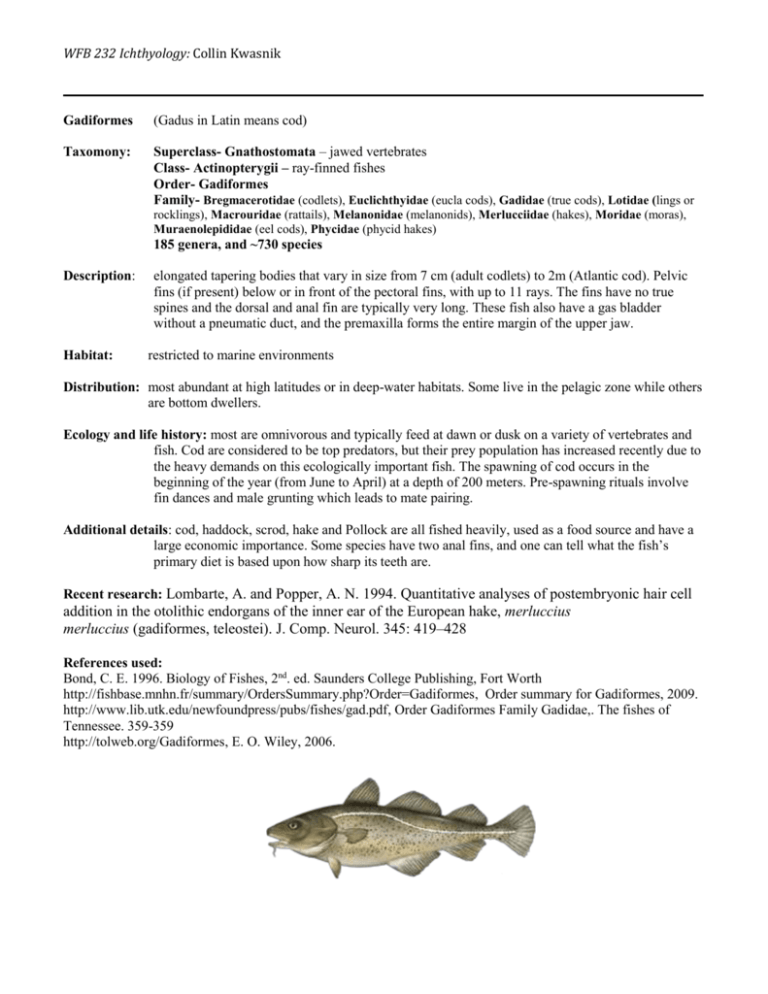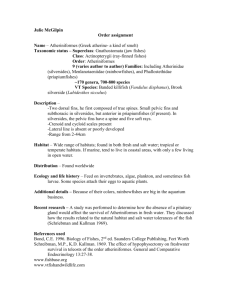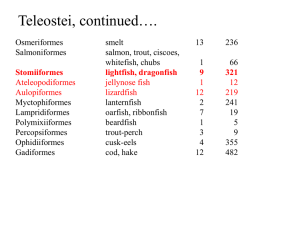WFB 232 Ichthyology: Collin Kwasnik Gadiformes (Gadus in Latin
advertisement

WFB 232 Ichthyology: Collin Kwasnik _____________________________________________________________________________________ Gadiformes (Gadus in Latin means cod) Taxomony: Superclass- Gnathostomata – jawed vertebrates Class- Actinopterygii – ray-finned fishes Order- Gadiformes Family- Bregmacerotidae (codlets), Euclichthyidae (eucla cods), Gadidae (true cods), Lotidae (lings or rocklings), Macrouridae (rattails), Melanonidae (melanonids), Merlucciidae (hakes), Moridae (moras), Muraenolepididae (eel cods), Phycidae (phycid hakes) 185 genera, and ~730 species Description: Habitat: elongated tapering bodies that vary in size from 7 cm (adult codlets) to 2m (Atlantic cod). Pelvic fins (if present) below or in front of the pectoral fins, with up to 11 rays. The fins have no true spines and the dorsal and anal fin are typically very long. These fish also have a gas bladder without a pneumatic duct, and the premaxilla forms the entire margin of the upper jaw. restricted to marine environments Distribution: most abundant at high latitudes or in deep-water habitats. Some live in the pelagic zone while others are bottom dwellers. Ecology and life history: most are omnivorous and typically feed at dawn or dusk on a variety of vertebrates and fish. Cod are considered to be top predators, but their prey population has increased recently due to the heavy demands on this ecologically important fish. The spawning of cod occurs in the beginning of the year (from June to April) at a depth of 200 meters. Pre-spawning rituals involve fin dances and male grunting which leads to mate pairing. Additional details: cod, haddock, scrod, hake and Pollock are all fished heavily, used as a food source and have a large economic importance. Some species have two anal fins, and one can tell what the fish’s primary diet is based upon how sharp its teeth are. Recent research: Lombarte, A. and Popper, A. N. 1994. Quantitative analyses of postembryonic hair cell addition in the otolithic endorgans of the inner ear of the European hake, merluccius merluccius (gadiformes, teleostei). J. Comp. Neurol. 345: 419–428 References used: Bond, C. E. 1996. Biology of Fishes, 2nd. ed. Saunders College Publishing, Fort Worth http://fishbase.mnhn.fr/summary/OrdersSummary.php?Order=Gadiformes, Order summary for Gadiformes, 2009. http://www.lib.utk.edu/newfoundpress/pubs/fishes/gad.pdf, Order Gadiformes Family Gadidae,. The fishes of Tennessee. 359-359 http://tolweb.org/Gadiformes, E. O. Wiley, 2006.










